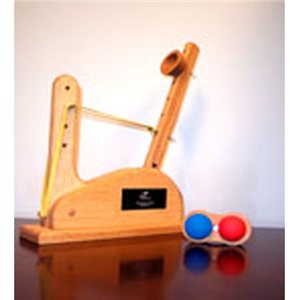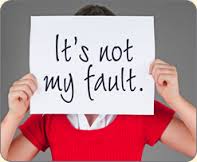Four Men and a Catapult!
 Imagine four grown men, setting up miniature catapults, and shooting ping pong balls down the length of two tables. They have identified specific variables such as draw back of the catapult arm, location of the stop pin, and the tension of the rubber band that drives the entire contraption….. And to top it all off, they are paired into two teams, competing against each other to see who can knock the evil queen off of her thrown, while she sits in her medieval castle! Sounds like child play right? You should hear the comments as they taunt each other, each team striving to out do the other.
Imagine four grown men, setting up miniature catapults, and shooting ping pong balls down the length of two tables. They have identified specific variables such as draw back of the catapult arm, location of the stop pin, and the tension of the rubber band that drives the entire contraption….. And to top it all off, they are paired into two teams, competing against each other to see who can knock the evil queen off of her thrown, while she sits in her medieval castle! Sounds like child play right? You should hear the comments as they taunt each other, each team striving to out do the other.
 Such is the fun that students enrolled in a Six Sigma Black Belt Course enjoy. The exercise is designed to let the students learn how to conduct a Design of Experiments. Simple explanation, they change specific variables associated with the catapult, recording the result after a series of test runs, then use a statistical package to predict how to adjust the variables to hit the queen sitting in her castle. The kicker is that the instructor gives them 9 shots. He moves the castle with the queen after each shot. They are scored according to accuracy. This is serious business!
Such is the fun that students enrolled in a Six Sigma Black Belt Course enjoy. The exercise is designed to let the students learn how to conduct a Design of Experiments. Simple explanation, they change specific variables associated with the catapult, recording the result after a series of test runs, then use a statistical package to predict how to adjust the variables to hit the queen sitting in her castle. The kicker is that the instructor gives them 9 shots. He moves the castle with the queen after each shot. They are scored according to accuracy. This is serious business!
It is fascinating to see these individuals learn to communicate and to cooperate. But even more interesting is their ability to identify the variables that affect their performance. They zero right in to stabilize, then control. Success is totally dependent on building a model that will make the prediction valid and repeatable.
From Variables to Values….
How predictable is your every day life? What are the most important variables that determine your success? What are your particular indicators of success? Is it happiness, effectiveness? Influence? Families? Some might call these outcomes, I would rather label them as values? Your values drive your behaviors. What values do you hold so important that you alter or control your behavior to align with them? Do you verbally indicate certain values, but practice others? If you have a significant other, does he or she have different core values that you do? And if so, how does that affect your relationship?
All great questions. Issues that lay at the heart of many strained marriages and or derailed lives. But the good news is that things can change. You can change.
There is a process:
- The first step is to identify your key values,
- Next evaluate whether those values will get you where you want to be.
- And finally assess your day to day behaviors to see whether they are in alignment with your values.
Identify Your Key Values
 Your day to day activities, with the associated choices you make, always determine where you will end up. Much like the bearings that you get by using a compass and a map, values orient you with the world, in relation to who and what you are.
Your day to day activities, with the associated choices you make, always determine where you will end up. Much like the bearings that you get by using a compass and a map, values orient you with the world, in relation to who and what you are.
Many activities have been developed to help you identify and rank your personal values. A quick Google search will take you to any number of available systems. Having used several over the years, I favor the ones that encourage deep self-awareness through scenarios that you build in your mind, rather than simply sorting a series of cards with value titles on them. The link below will take you one that encourages self-assessment. Please take some time to work through the process that Kevin suggests. I promise that it will be a solid investment on your part.
http://www.inc.com/kevin-daum/define-your-personal-core-values-5-steps.html
Evaluate Your Values for Validity
There are a couple of very good ways to make sure that your values are really YOUR VALUES…..
Once you have made your list, you can write or print them on a 3×5 index card and carry that in your pocket. You might also want to develop pertinent questions for each of your values. Each question will express what you want to ask yourself in any given situation to make sure you are staying aligned with that value. You can visit your goals each day by pulling that card out and asking yourself those questions. You have three choices if you consistently find that your actions or behaviors are not aligned with your states values. Change your stated values to align with your behaviors, change your behaviors to align with your values, or you could just do nothing. Be warned though, that last option comes with a downside. Actions that don’t agree with your values tend to diminish your self-esteem, and when evident to others, their trust in you. Personally, I like option number 2.
Here are some examples from my values card:
- Dignity: “Have I conveyed to others that I value them by listening to their ideas and by recognizing their efforts?”
- Loyalty: “Have I helped those around me to be successful in their efforts?”
- Accountability: “Have I honored commitments, accepted responsibility, and expected the same of others?”
As Mahatma Ghandi said;
"Your beliefs become your thoughts. Your thoughts become your words. Your words become your actions. Your actions become your habits. Your habits become your values. Your values become your destiny."
Daily Assessment for Alignment
You need to understand that behaviors can consist of things you do, as well as things that you choose not to do. When faced with a choice, your subconscious brain analyses the options and recommends a course of action. Your conscious brain can over-ride the advice. So don’t just assume that you are what you are. One of the greatest blessings of being a human being is that you have autonomy. You can make choices, change your values, and practice at becoming the person you really want to be…..
So….. change some of those factors on your catapult, and LET HER FLY!
Till next time…..






